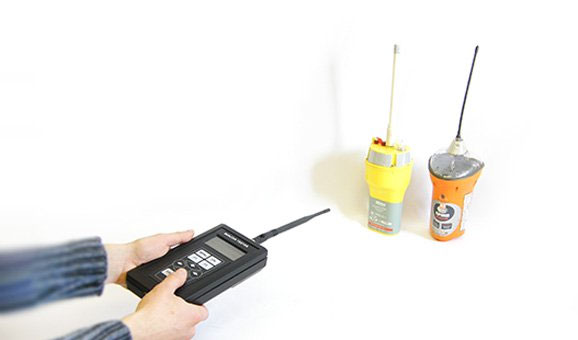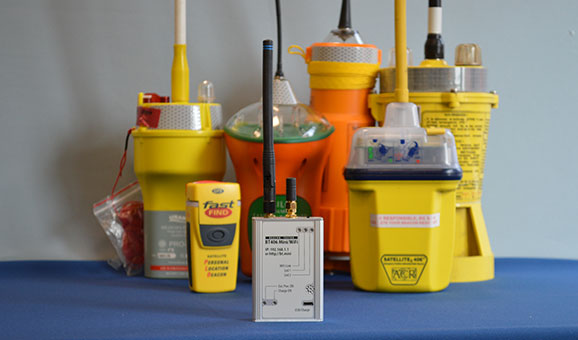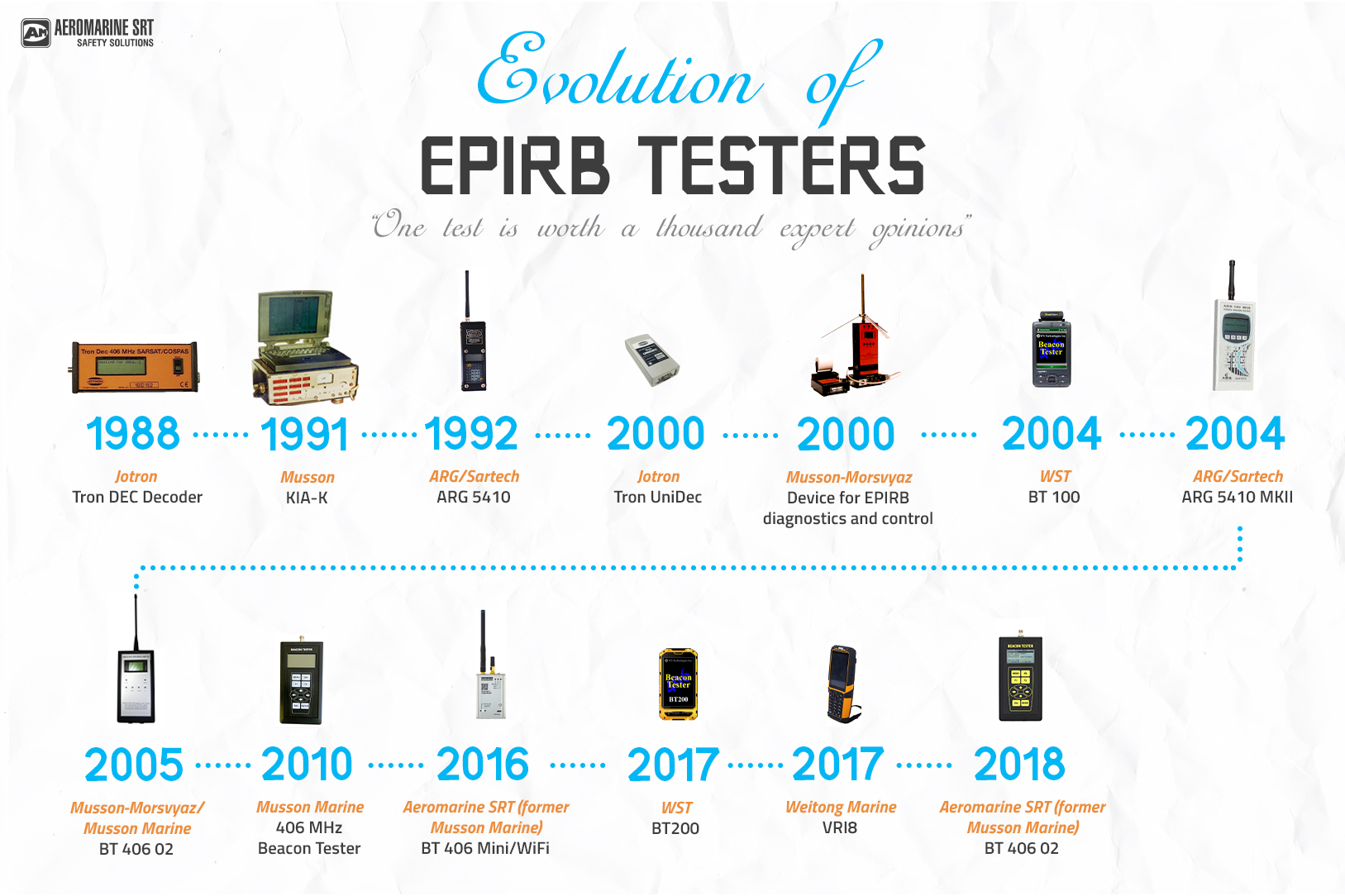Servicing and testing of 406MHz EPIRBs
Marine regulations require that a 406 MHz EPIRB is tested and, if necessary has its batteries replaced at intervals specified by the manufacturer. Hydrostatic releases must be replaced by their expiry dates. These are usually marked on the release mechanism.
406 MHz EPIRBs are to be physically examined and the self-test function checked, at least once per month.
The EPIRB is subject to annual performance tests under SOLAS regulation IV/15.9: "Satellite EPIRBs shall be tested at intervals not exceeding 12 months for all aspects of operational efficiency with particular emphasis on frequency stability, signal strength and coding" and shore-based maintenance at intervals not exceeding five years.

The purpose of an annual testing is to determine that EPIRB is operational as defined in appropriate performance standards - the International Maritime Organization (IMO) Performance Standard (A.810) and IEC standard, IEC 61097-2: COSPAS-SARSAT EPIRB – Satellite emergency position indicating radio beacon operating on 406 MHz – Operational and performance requirements, methods of testing and required test results, and RTCM 11000.3 - Standard for 406 MHz Satellite Emergency Position-Indicating Radiobeacons (EPIRBs), required by U.S. Federal Communications Commission and defines performance requirements for EPIRBs used on U.S.-registered vessels.
The annual testing of 406 MHz satellite EPIRBs is required by SOLAS regulation IV/15.9. The volume of annual beacon testing is described in IMO MSC.1/Circular 1040. MSC/Circ.955 further recommends that annual testing of the EPIRB shall be carried out concurrently with the Annual Safety Radio Survey. Shore-based maintenance volume is described in IMO MSC/Circ.1039.
The testing should be carried out using suitable test equipment, such as EPIRB Tester, capable of performing all the relevant measurements required in these guidelines. All checks of electrical parameters should be performed in the self-test mode, if possible.
Preliminary test procedure
a) Ensure the installation must be such that the EPIRB will not be caught up in any rigging or structure if the ship should capsize. The unit must be capable of automatic release when submerged and automatic activation when placed in water. Additionally, the unit must also be capable of manual release and manual activation.
b) The battery date must not be expired.
c) The EPIRB(s) must be registered with NOAA. Verify its ID by EPIRB Tester.
d) EPIRB must be FCC certified for GMDSS (must have a label so stating).
e) EPIRB should have a self test capability.
Procedure of the EPIRB annual performance testing
- Check position and mounting for float free operation. Verify that EPIRB is installed in an easily accessible position and is ready to be manually released and capable of being carried by one person into a survival craft.
- Verify that the lanyard is firmly attached, in good condition, neatly stowed, and not tied to the vessel or the mounting bracket.
- Carry out visual inspection for defects.
- Carry out the self-test routine.
- Check that the EPIRB ID and other information (include call sign and MMSI of the ship) is clearly marked on the outside of the equipment.
- Decode the EPIRB identity number and other information confirming it is correct and the same as that marked on the EPIRB. Write down the 15 Digit Hexadecimal Number.
- Check the registration through documentation (sticker) or directly with NOAA
- Check battery expiry date
- Check hydrostatic release(s) expiration dates
- Check the emission in the 406 MHz band using the self-test mode or an appropriate device to avoid transmission of a distress call to satellites.
- If possible, check emission on the 121.5 MHz frequency using the self-test mode or an appropriate device to avoid activating the satellite system.
- Check that no transmission has been started after the test and remounting of the EPIRB in its bracket.
- Check for the presence of beacon operating instructions.
The testing should be carried out using suitable test equipment capable of performing all the relevant measurements required in these guidelines. All checks of electrical parameters should be performed in the self-test mode, if possible.

One of such professional test equipment are 406MHz Beacon Tester or EPIRB Tester Mini Wi-Fi, specially designed under IMO requirements
Procedure of monthly EPIRB Testing
Expiry dates on hydrostatic releases fitted to oat free 406 MHz EPIRBs should be monitored.
The GMDSS requires that each EPIRB shall be examined at least once a month to check:
. built-in self-test performed as per the recommendations in the manufacturer’s user manual;
. its capability to operate properly, particularly its ability to oat free (where required to do so) in the event of the vessel sinking;
. how secure it is its mounting; and
. for signs of damage.
If there is any doubt, it is strongly recommended that this function is carried out, by a shore-based maintainer at the earliest opportunity, for further advice refer to MSC/Circ.1039. Refer to Section 15.9 for a summary all routine testing requirements.
Note: Some manufacturers recommend using the TEST function sparingly to maintain the battery life. Testing therefore should be done in accordance with the manufacturer’s user manual.
EPIRB Shore-based maintenance
Shore based maintenance of satellite EPIRBs shall be carried out in accordance with the requirements of MSC Circular 1039 at an interval not exceeding 5 years or when the battery replacement is due.
At intervals not exceeding five (5) years, the 406 MHz satellite EPIRB should be serviced (i.e. Maintenance Servicing) by a Shore-Based Maintenance (SBM) provider who may be the manufacturer’s servicing agent.
This maintenance servicing is counted as an annual testing referred to in the first paragraph. We suggest that the maintenance servicing be scheduled, as far as practicable, to coincide with the time when the satellite EPIRB’s battery should be changed.
The testing should be carried out by persons with the necessary skills and competency and having the required test equipment. Caution should be exercised at all times during the testing to avoid transmitting false distress alerts.
The volume of shore-based maintenance is described in the Guidelines for shore-based maintenance of satellite EPIRBs (MSC Circular 1039) and the requirements for annual testing (MSC Circular 1040/Rev.1 and MSC Circular 1123).
Downloads
- Guidelines for shore-based maintenance of satellite EPIRBs. MSC/Circ. 1039.
- Guidelines for annual testing of L-band satellite EPIRBs. IMO MSC/Circ.1123
- GMDSS Inspection condution how to
- 406 MHz Satellite EPIRB Annual Test Report by DNV GL




Be the first to comment